Tom's Guide Verdict
The innovative Samsung S95B combines Samsung’s consumer electronics know-how with the best aspects of both OLED and quantum dot technology, stumbling only slightly—but significantly—when it comes to its picture quality and its OS.
Pros
- +
Generally superb picture quality
- +
Good audio
- +
Excellent choice for gaming
- +
Solar-powered remote
Cons
- -
Imperfect blacks
- -
Poor interface, OS
- -
No Dolby Vision support
Why you can trust Tom's Guide
Price: $2,999.99
Screen size: 65 inches
Model: QN65S95BAF
Resolution: 3,840x2,160
HDR: HDR10, HDR10+, HLG
Refresh Rate: 120 Hz
Ports: 4 HDMI, 2 USB
Audio: 60W
Smart TV Software: Tizen
Size (without stand): 56.9x32.5x1.6 inches (HWD)
Weight (without stand): 47.8 lbs.
The Samsung 65-inch Class S95B OLED 4K Smart TV (QN65S95BAF or QE65S95B in the UK) signifies a big step forward for the jack-of-all-trades consumer electronics company. It’s not just Samsung’s first OLED set, it’s also its first to combine OLED with quantum dots, resulting in a QD-OLED TV that promises the best of both technologies: superior color, brightness, and contrast in a single package. And Samsung comes tantalizingly close to conquering that mountain.
But the distance between “close” and “exact” proves to be a gulf with the S95B Series. For all the set gets right with its picture, sound, gaming performance, and even its remote control, its few minuscule missteps are amplified by a price ($2,999.99) that’s just high enough to make you think twice. This may be one of the best TVs out there for certain kinds of shoppers, but overall you can do better—and cheaper.
Samsung 65-inch Class S95B OLED 4K Smart TV (QN65S95BAF) review: Pricing and availability
Samsung offers two TVs in its S95B line: the 55-inch QN55S95BAF and the 65-inch QN65S95BAF, which is the one we evaluated.
- Samsung 55" Class S95B OLED 4K Smart TV (QN55S95BAF): $2,199.99
- Samsung 65" Class S95B OLED 4K Smart TV (QN65S95BAF): $2,999.99
Because both models are equipped with identical hardware despite the different screen sizes, we expect performance to be comparable between the two.
While these prices may seem high, this is partially due to Samsung's use of QD-OLED displays rather than the less expensive W-OLED displays used in TVs like the LG C1 OLED TV. Unfortunately, it seems Samsung will not be unveiling cheaper OLED TVs anytime soon, so the S95B is your best bet for a Samsung OLED.
Samsung 65-inch Class S95B OLED 4K Smart TV (QN65S95BAF) review: Design
OLED sets are renowned—notorious?—for having ultrathin screens, and the QN65S95BAF is no exception. Along every edge, the screen measures a trifle more than one-eighth inch thick, which, combined with the barely-there bezels (measuring about one-sixteenth of an inch on the top and sides and a quarter-inch on the bottom), give the TV an unusually sleek look, even when compared with something like the Sony Bravia XR A80J OLED (which, barely one-quarter inch thick, isn’t exactly bulky). The control box in the back adds about an inch and a half to the depth, but the set’s svelteness is impressive nonetheless. All told, the QN65S95BAF measures 56.9x32.5x1.6 inches (HWD) without the stand, and if you want to use the 300x200mm VESA holes to mount the TV on the wall, that’s all you’ll notice.

Otherwise, you’ll have to deal with the center-positioned stand, which raises the TV about 2.6 inches and adds 10.7 inches to the depth (and just a tiny bit of wobble to the screen). This isn’t that much of a problem, though the stand is beefy and a little cumbersome to set up; you need to interlock two pieces (each fairly heavy) and then screw them to the TV—which, we’ll remind you, has a mighty thin screen. We usually use the shipping box to set up the stand, but the stand’s size and weight made that tough here; if you have something sturdier that sits higher off the ground, use that instead. (And watch the screen.)
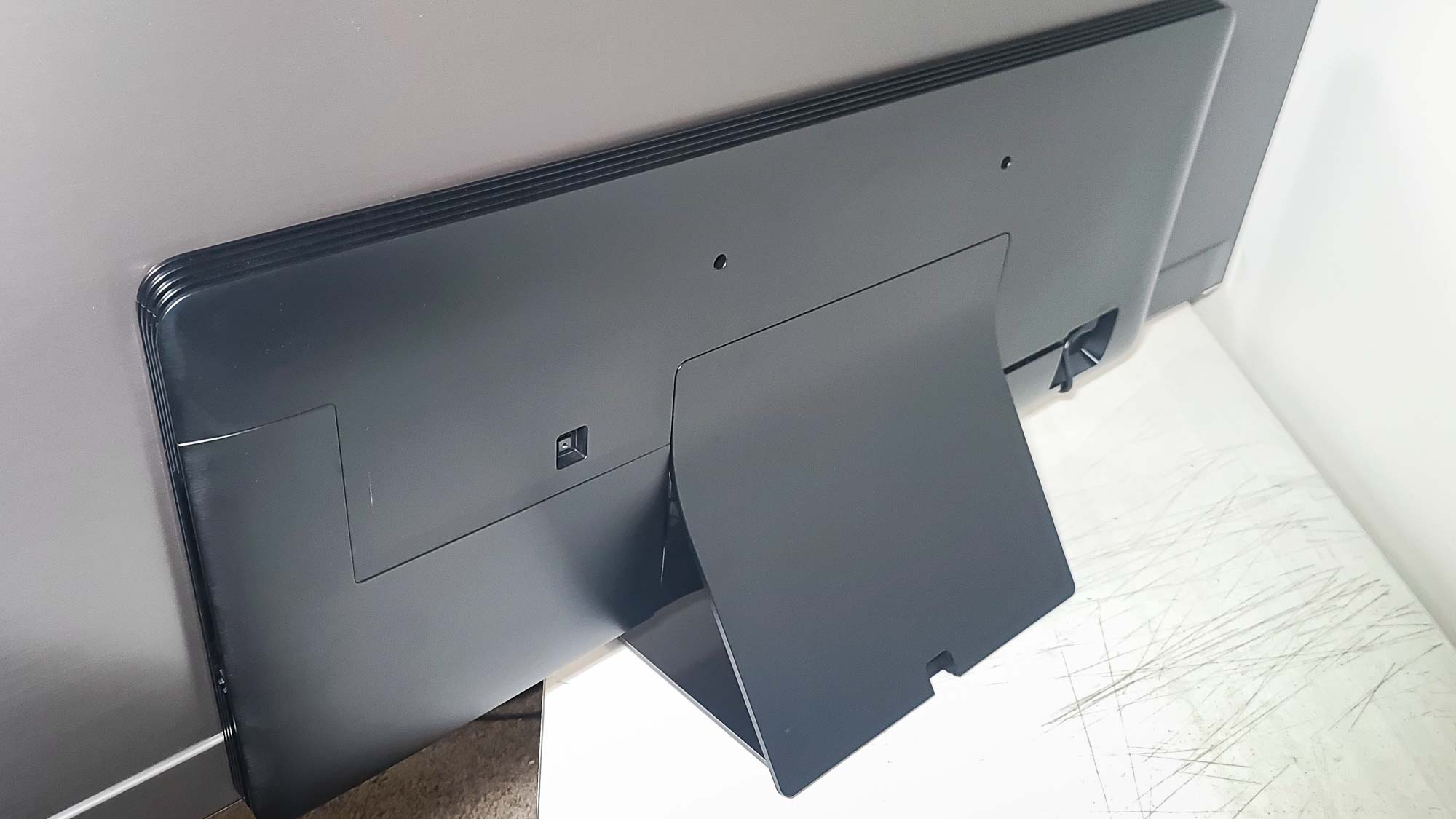
Two USB ports and two HDMI ports (one the eARC port) face out from the right edge of the screen; just inside from these are two more HDMI ports, digital audio out, an Ethernet jack, and an Ex-Link service port, all aiming downward.
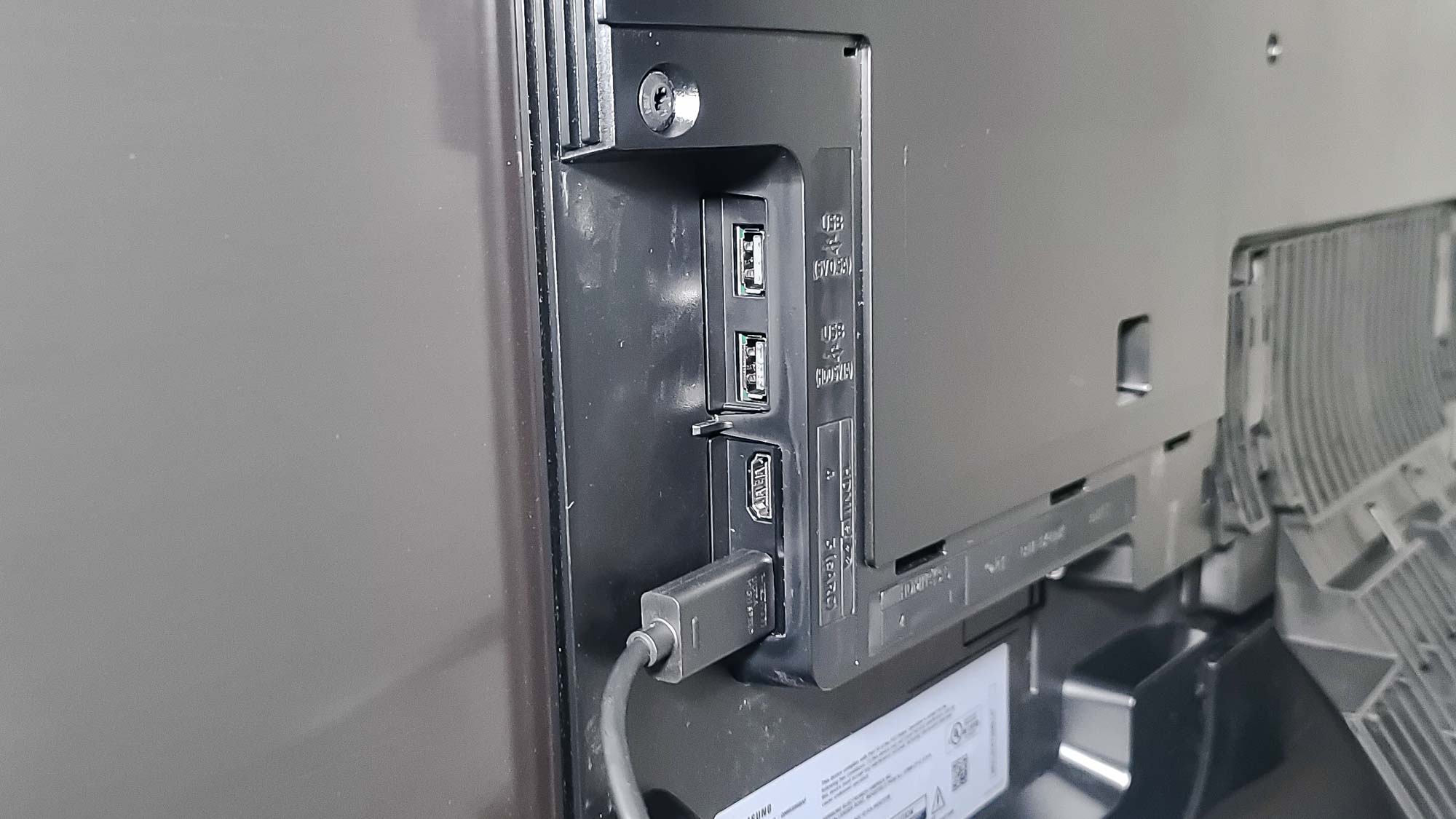
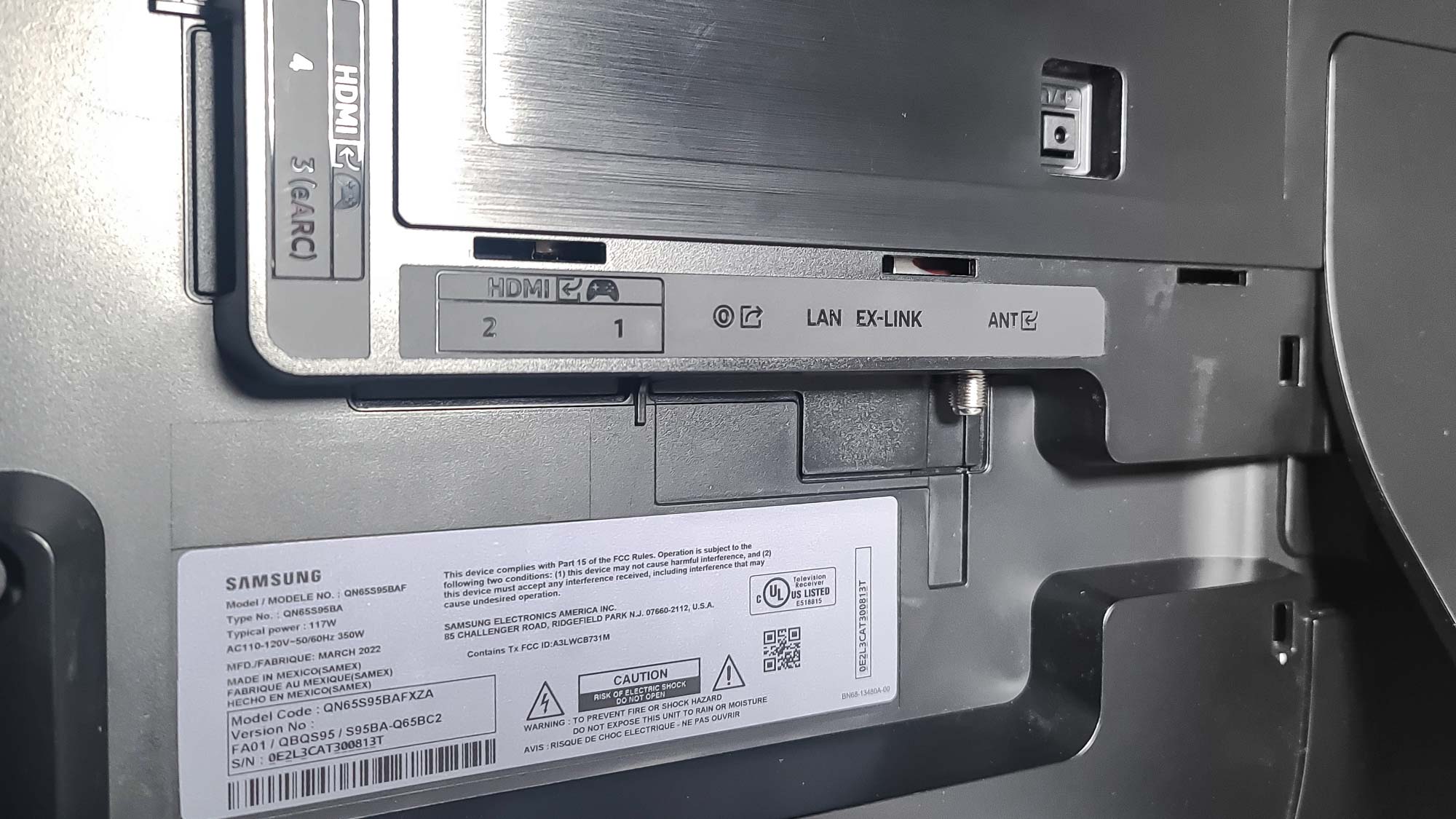
All four HDMI ports support 4K 120Hz, which is a nice feature we’re happy to be seeing on more and more TVs. The power cable angles off the left edge of the control box. The control box and stand both have built-in channels for cable routing, which is a way to keep your setup tidy.
Samsung 65-inch Class S95B OLED 4K Smart TV (QN65S95BAF) review: Performance
One of the first TVs on the market to fuse OLED and quantum dot technologies into a single set, the QN65S96BAF all but promises next-generation picture quality by dint of its existence—and largely delivers. We tested the set using an X-Rite i1 Pro spectrophotometer, a SpectraCal VideoForge Pro pattern generator, and Portrait Displays’ Calman calibration software and encountered some outstanding results.
In SDR Filmmaker Mode (the closest to an out-of-the-box calibration option) with the Brightness Optimization setting off, the QN65S95BAF’s Delta-E value, which measures how the source color differs from the displayed color (with lower numbers being better) was a fine 3.0184, and the picture covered exactly 100% of the Rec.709 color gamut. Using the same settings, the set’s brightness registered as 329.5 nits—a high result for an OLED TV. For comparison, the Sony A80J, one of our favorite sets of 2021, was slightly less accurate in its Custom mode with a Delta-E of 3.3645, but covered more of the Rec.709 gamut (110.4%).
We saw even better brightness from the QN65S95BAF with HDR content, with the set measuring about 1,050 nits with a 10% field (our standard for brightness readings), versus just over 600 nits for the Sony A80J. HDR color was excellent, too, with the Samsung covering 99.8% of the UHDA-P3 color gamut, more than the Sony’s 97.2%. In short, the QN65S95BAF’s picture is bright and both rich and accurate with its colors.
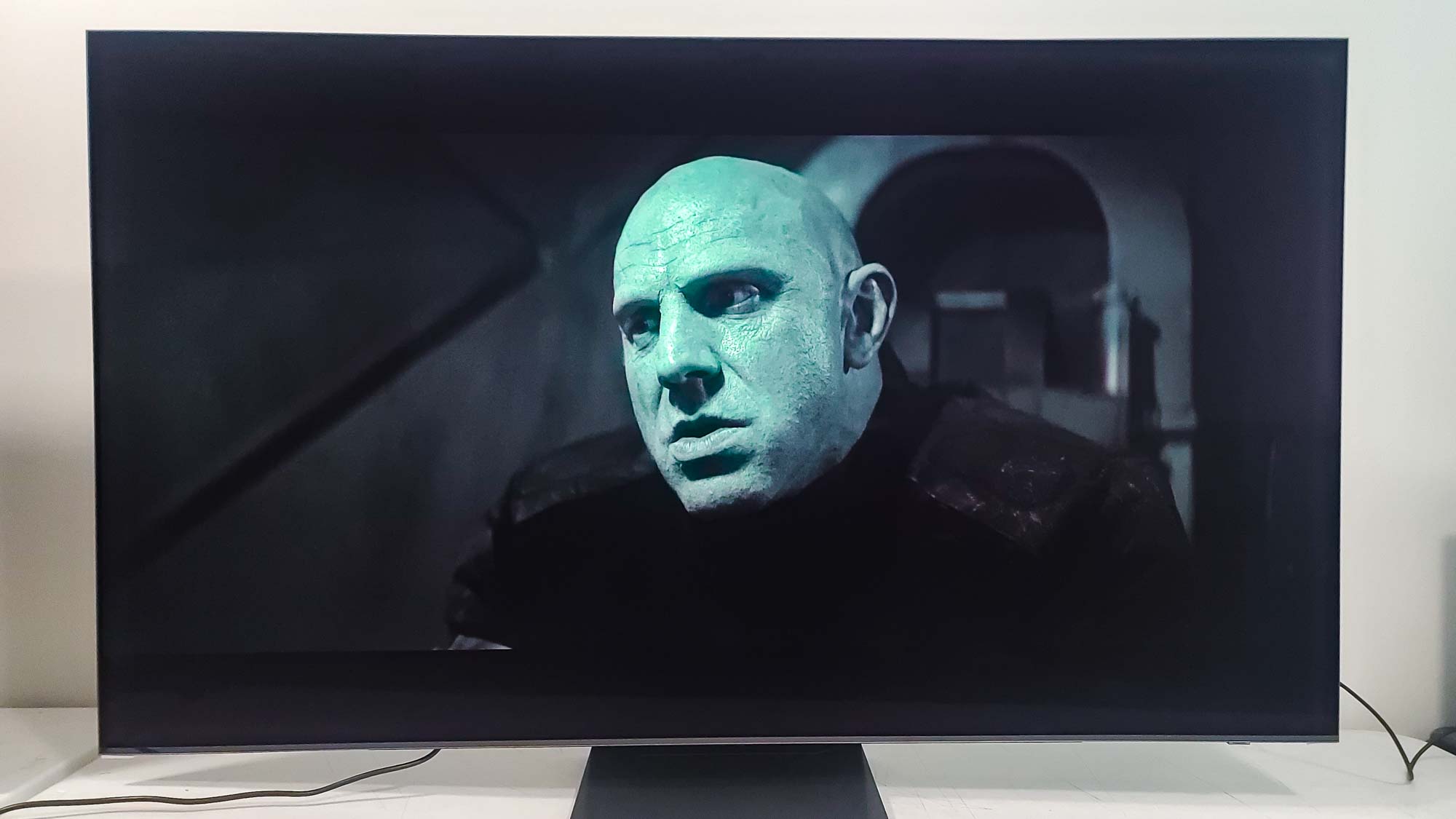
These results were mirrored in every piece of content we watched on the QN65S95BAF. The dusty sandscapes of Arrakis popped to life when watching Denis Villeneuve’s Dune, and the more shadowy, claustrophobic interior scenes felt appropriately tense. The on-the-brink Gotham City of The Batman sparked with its ultrarealistic grit and glory. Disney’s Encanto burst with the warm Colombian colors that define its magical world, whereas a different kind of (partially) animated film, Spider-Man: No Way Home, entranced anew with its web-choked, multiverse-spanning action. The 1080p version of Mission: Impossible—Fallout upscaled well to 4K with some, but not distractingly much, fuzziness coming along for the ride.
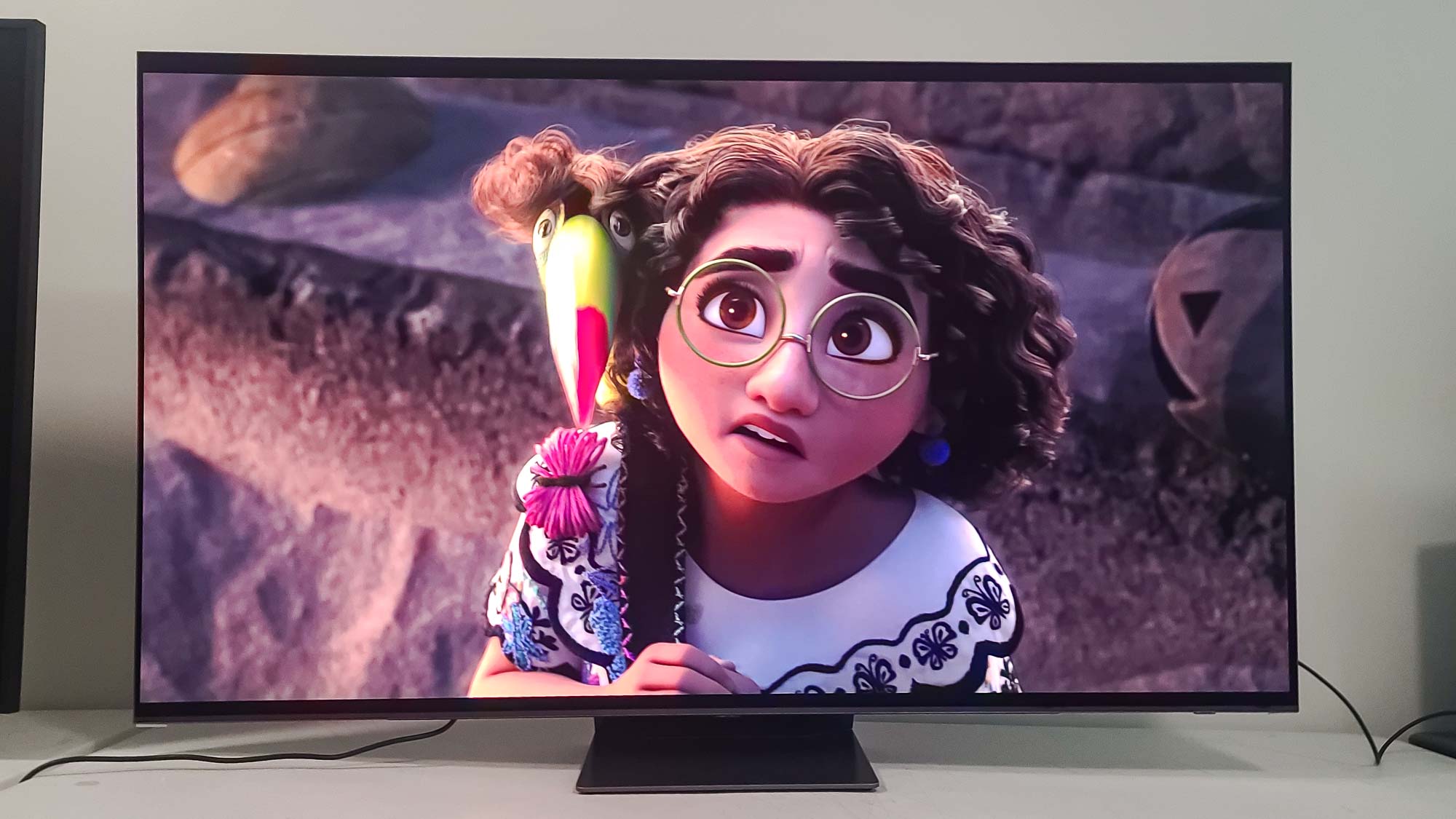
The picture on all of these movies, as well as a few TV series and YouTube videos we tried, plus our standard full-field, one-screen color screens, dazzled from anywhere in the room, as the set maintained almost its full color fidelity at even extreme angles relative to the screen. The QN65S95BAF does not support Dolby Vision for HDR, but we had no complaints about any of the HDR10 video we sampled.
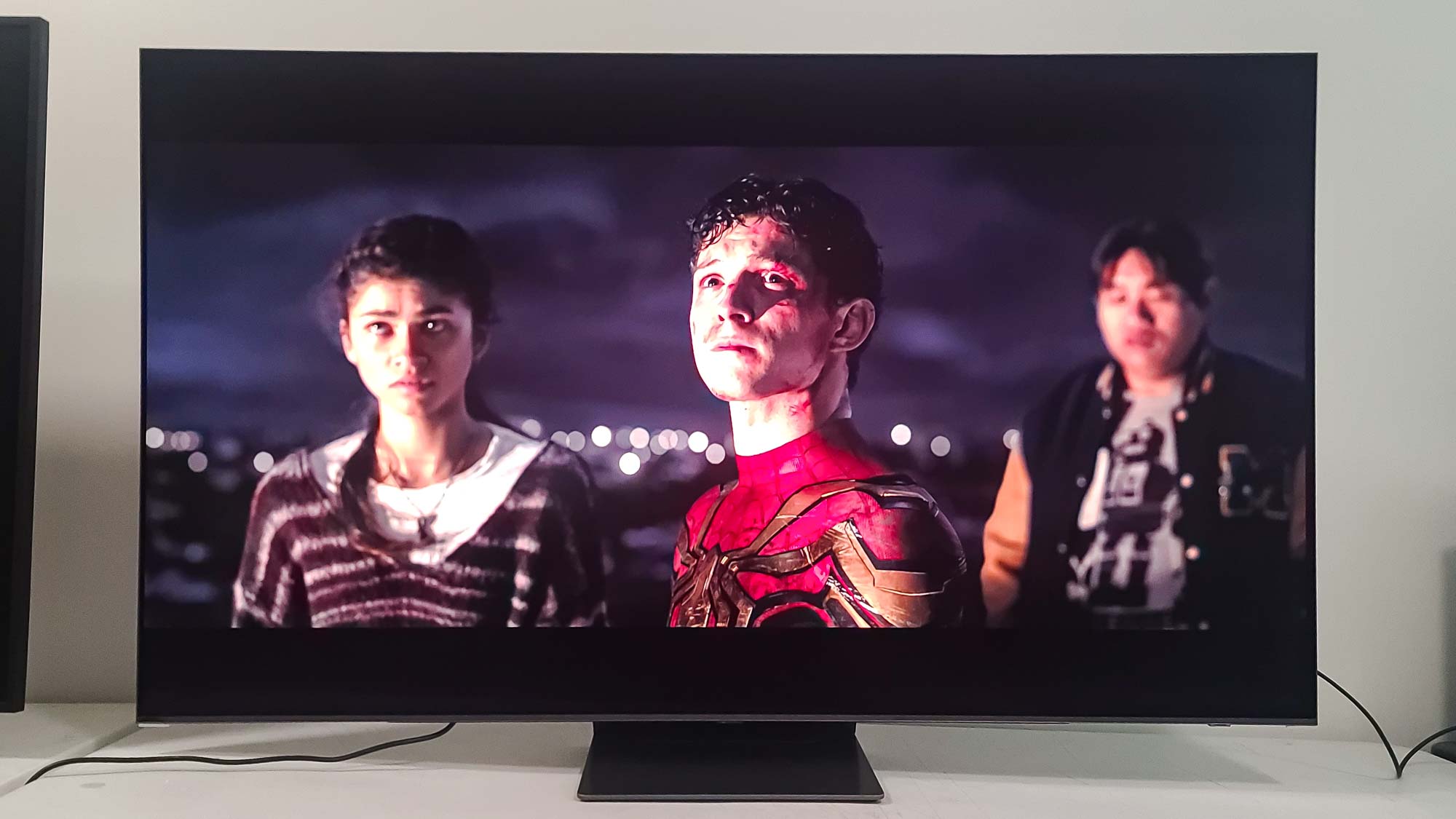
So where’s the “but”? Although an OLED TV should, in theory, have a perfect black level (because any pixel not in use is turned completely off) that results in infinite contrast, the QN65S95BAF doesn’t. Make no mistake, its black is quite good—the simmering shadow play in the early scenes of Dune looked properly imposing, for example, as did the sprawling, inky vistas of The Batman. The differences are barely perceptible (if at all) in ideal, dark-room conditions, but raised blacks are detectable if watching in a setting with even minor ambient light. When I loaded up a contrast test pattern that should show a gradual change from pure black to pure white, a dark box around the first test panel was clearly visible—whereas on the Sony A80J, viewed under identical lighting conditions in the same room, it wasn’t.
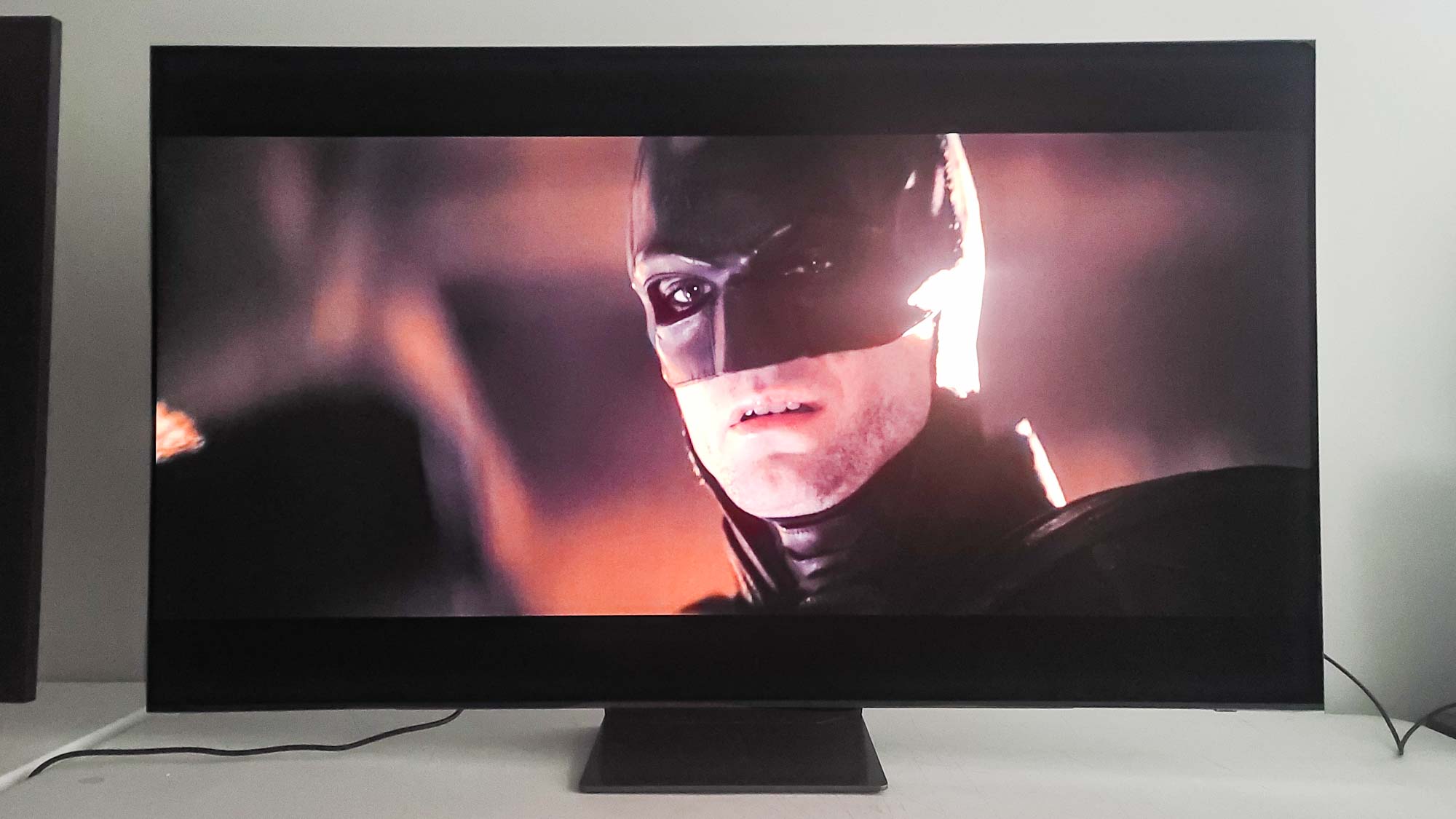
This may be due to some undesirable interaction the quantum dots and the OLED panel; as this is the first QD-OLED set we’ve reviewed, it’s difficult to say for sure. And, to reiterate, seeing the differences is not easy with most video. But for a TV this expensive, every detail counts, and this is one where the QN65S95BAF just fails to rise to the challenge.
Samsung 65-inch Class S95B OLED 4K Smart TV (QN65S95BAF) review: Audio
If the sound produced by the QN65S959BAF’s 60-watt speakers isn’t as good as its picture, it’s still more than good enough to satisfy any non-audiophiles. (They, and anyone less forgiving, will want to consider one of our best soundbars.)
The set never gets too loud, but music, dialogue, and sound effects sound crisp and clear, with no clipping, straight to the top of the volume range. No distortion was evident in either high-soaring soprano vocals, and the pulsing bass throughout The Knife’s “Silent Shout” maintained solid presence despite lacking the chest-thumping power some may want. Like the Sony A80J, this is a TV you won’t mind listening to.
Samsung 65-inch Class S95B OLED 4K Smart TV (QN65S95BAF) review: Gaming
As good as the QN65S959BAF is with video content, it may be even better for gaming. As measured with a Leo Bodnar 4K Signal Lag Tester, the set’s input lag is a captivatingly low 9.2ms—far below our 20ms threshold for a “good” gaming TV, and straight into competition for one of the best gaming TVs on the market.
Except for Dolby Vision, the QN65S95BAF supports all the major technologies found in the current generation of gaming consoles (as I discovered when I plugged in my Xbox Series X), including support for FreeSync Premium, variable refresh rate (VRR), and Samsung’s version of Auto Low Latency Mode (ALLM). These settings and more (such as for specific game genres) are instantly accessible from a pop-up bar when the TV is in Game mode.
This level of unintrusive control is appealing, but the more important thing is that games play well, too. In Assassin’s Creed Valhalla, for example, the movement was constantly smooth, with realistic melty colors assaulting the senses, and the searing light of the sun casting a reflective sheen on the wintry slopes and shores that constitute the game’s ravishing open world.
Samsung 65-inch Class S95B OLED 4K Smart TV (QN65S95BAF) review: Smart features
One significant drawback of the QN65S95BAF is that it uses Samsung’s Tizen smart interface. Like a lot of the other smart TV operating systems, it throws a ton of information at you, but it’s more haphazardly organized and can take a while to navigate.
From the TV’s home screen (which it refers to as Media), an abbreviated menu leads to Privacy Choices, Search, and Ambient (for displaying art during off-hours). If all you care about are apps, you’ll be fine; there’s a wide selection, and the (editable) horizontal list is near the top. Below that is the row for Recent and On Now selections (the latter of which never displayed anything I was interested in), with the fairly anemic Samsung TV Plus free service (do I even want to know what The Boxtrolls is?) below that. After that, the dynamic, themed collections start, and the notability stops.
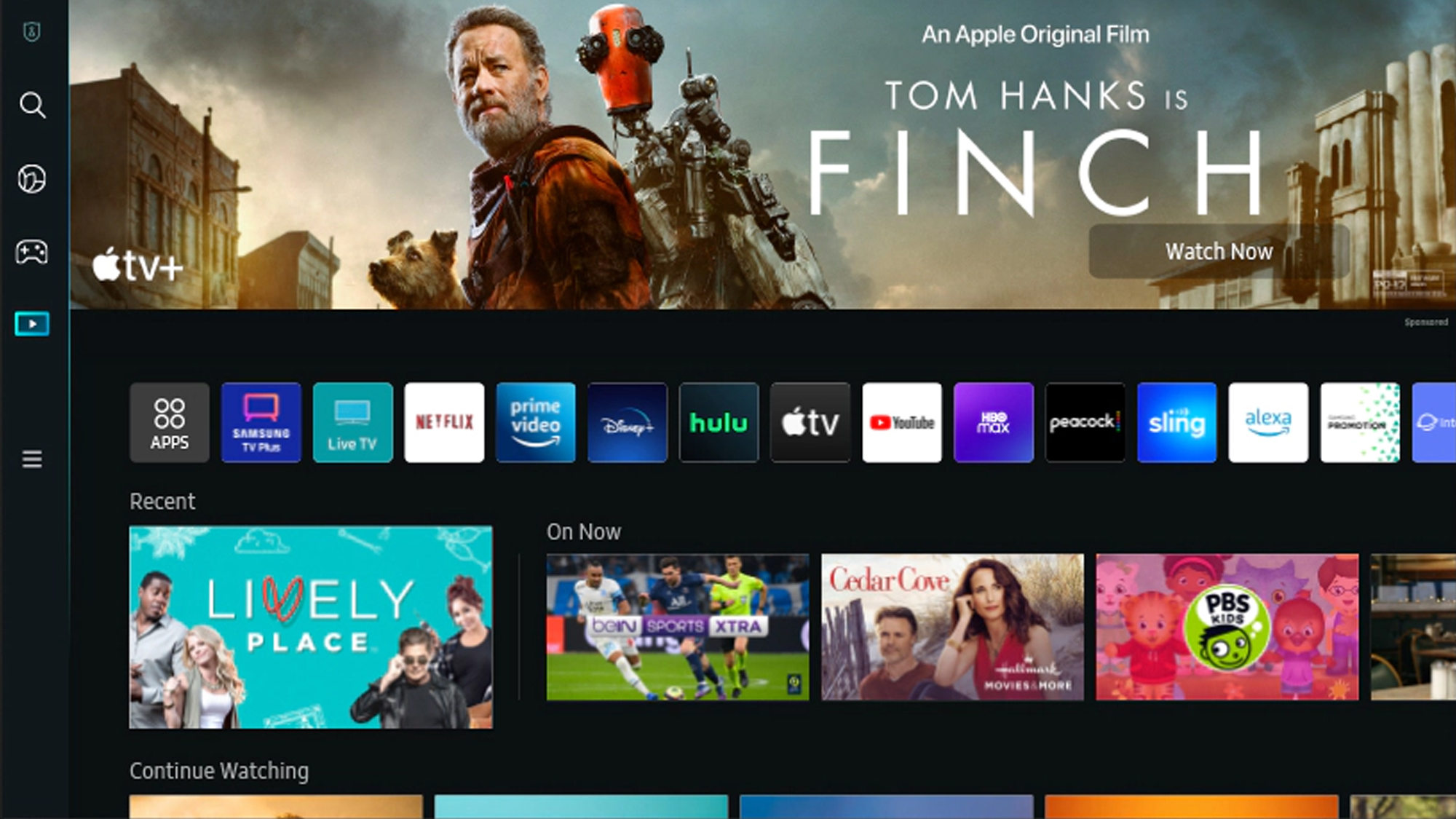
Multiple times while trying to scroll, I got stuck at the bottom of the screen and couldn’t find the cursor to navigate my way up without moving the rest of the screen along with me. (If you know what the Scroll Lock key on your computer keyboard is used for, it was a lot like that.) But I never found myself needing or wanting to watch most of what was surfaced for me anyway. In most cases, you’re better off using other control methods, and lots are supported, with Amazon Alexa, Apple AirPlay 2, Google Assistant, and Samsung’s own Bixby among them.
Tizen may have made more sense when it was released in 2015 and proprietary OSes like this were more common and less developed, but compared with something like the intuitive, streamlined Google TV, it’s really showing its age. If it was once intended as an all-encompassing platform, its having been removed from Samsung’s phones and Galaxy Watch smartwatch line make it now feel more like a relic than an integrated part of the TV experience.
Samsung 65-inch Class S95B OLED 4K Smart TV (QN65S95BAF) review: Remote
Samsung has performed one intriguing trick with its latest generation of remote control: It’s solar powered. Just turn over the black SolarCell Remote to reveal a hefty-sized solar panel, leave it upside down in the sun (or in a brightly lit room, though charging may take longer), and you’ll never have to worry about your remote dying again. This is a welcome nod to both usability and sustainability that, in the long run, is sure to save you money and frustration.
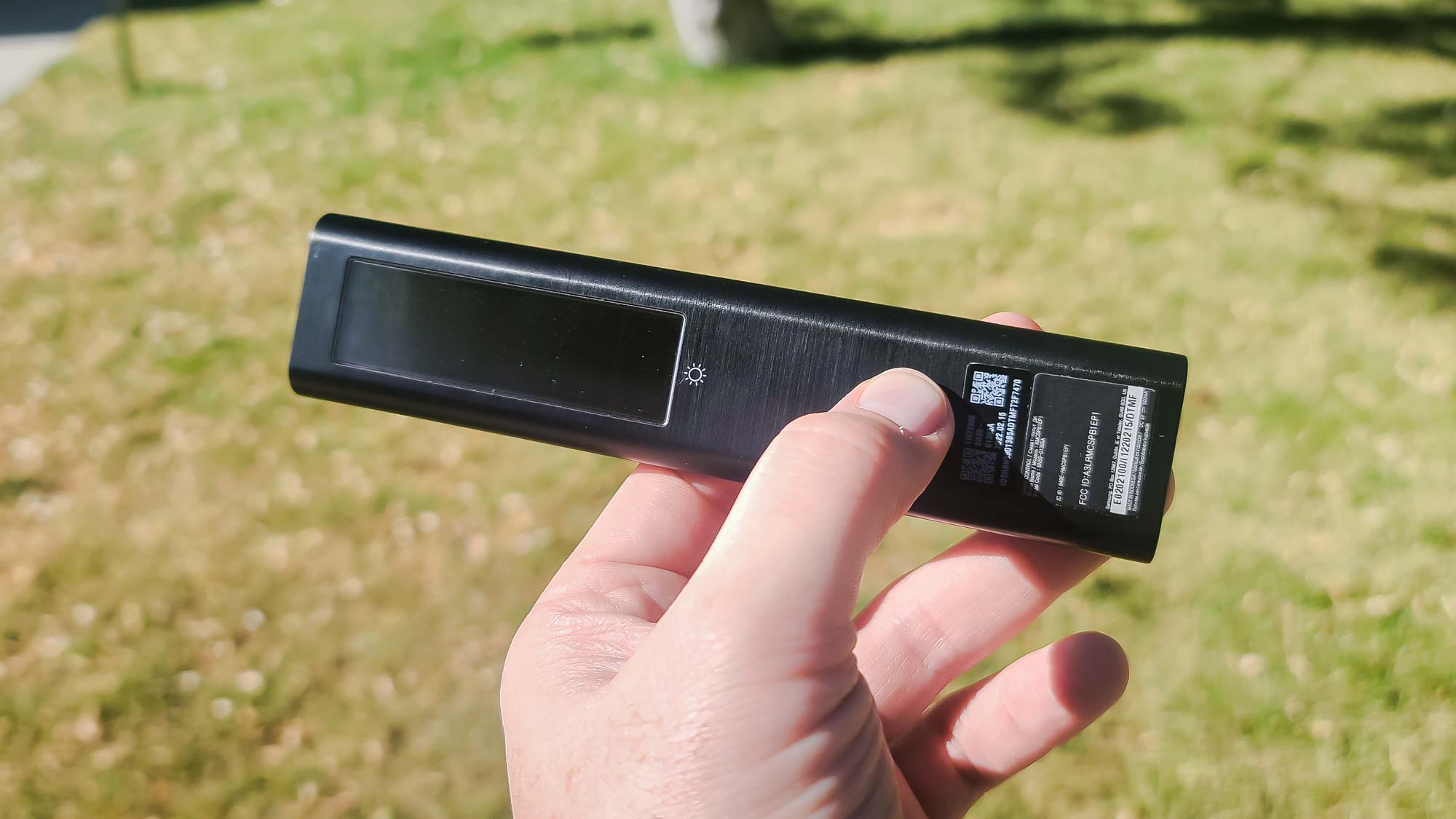
Too bad you’ll make up for the latter in the long run by using the remote. It’s a bare-bones affair that does little to solve the QN65S95BAF’s basic navigational issues. Oh, the four-way direction pad with the central selection button; the Voice Control switch; the Volume and Channel rockers; and the Back, Home, and Play/Pause buttons all work just fine. One of the other two controls at the top opens a three-way menu for colors, numbers, and settings, and the other lets you access Multi view configuration for displaying content from another device on your TV screen—none of this is everyday-use important. Better are the four buttons at the bottom, which provide one-touch access to Samsung TV Plus, Netflix, Prime Video, and Disney+, though you can’t reprogram these.
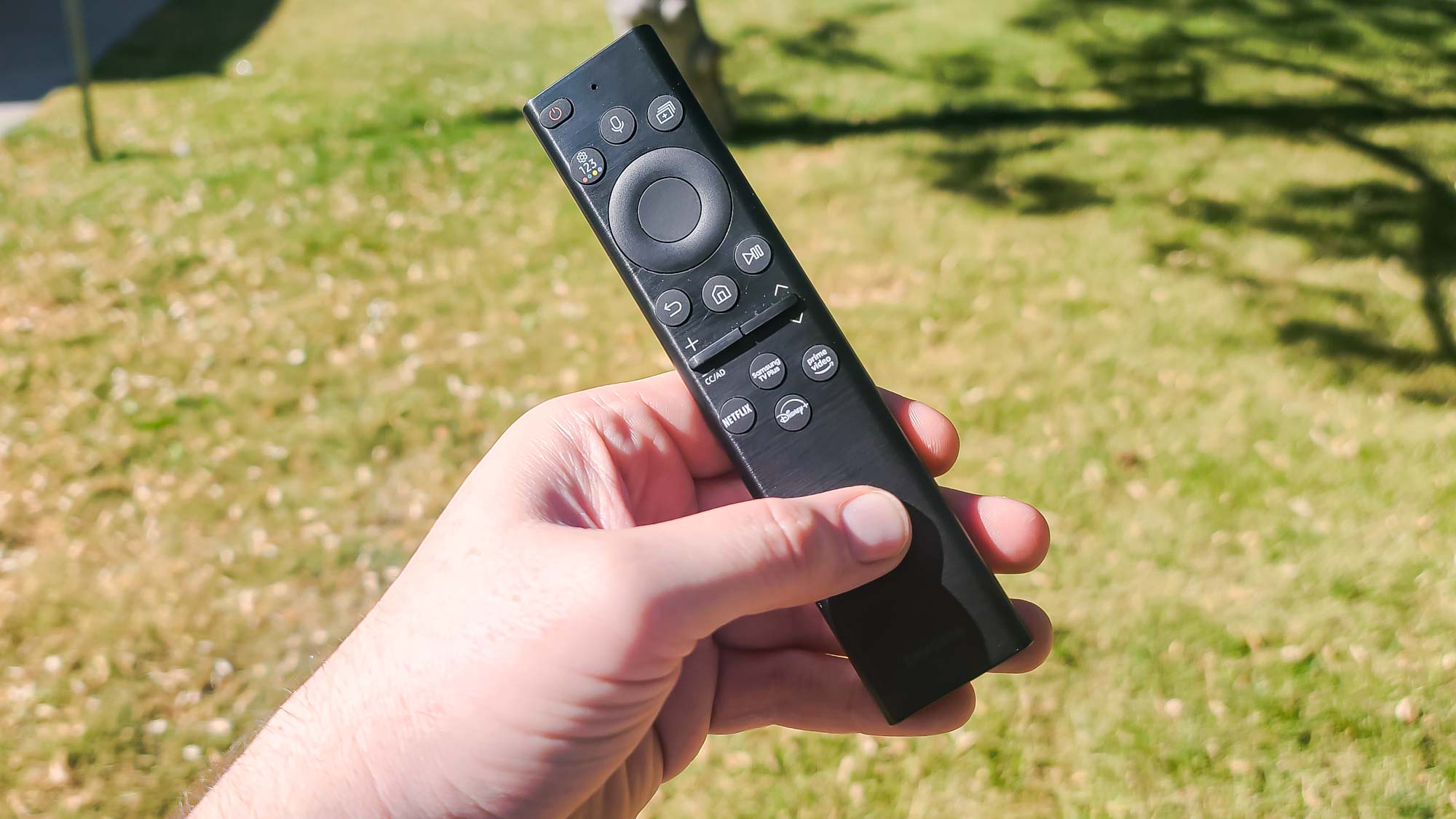
There’s no single button for changing external inputs and no dedicated Mute button, for example, and changing any setting (assuming you can find it in the menus) is a multiclick process. There are some “secret” functions you can perform via the remote (such as muting the sound, bringing up the Accessibility screen, or displaying the Game Bar), but you’ll have to page through the integrated remote tutorial to find them. I’m a big fan of the solar panel, but a few more buttons would have been a different kind of bright idea.
Samsung 65-inch Class S95B OLED 4K Smart TV (QN65S95BAF) review: Verdict
There are no two ways around it: The Samsung 65" Class S95B OLED 4K Smart TV (QN65S95BAF) is an excellent TV. With top-tier picture quality, surprisingly good sound, a forward-thinking remote control, terrific gaming capabilities, and an eye-catching design, it would represent the state of the TV art even if it didn’t also signal some serious technical innovation with the union of quantum dot and OLED technologies.
That marriage is the tiniest bit rocky, though, thanks to its effects on the set’s blacks (which should be any OLED set’s crowning glory), and the superannuated Tizen operating system that leaves this brand-spanking-new set showing its age right out of the box.
For $3,000, that’s a bit much to ask—even given the myriad positives—considering the stiff competition out there from the likes of Sony and LG, which are nipping at Samsung’s heels with new TVs that will build on the advances from their excellent last-generation sets, the A80J and the C2 respectively. Those new models may prove worth waiting for. But as good as the Samsung QN65S95BAF is in many ways, it rates much closer to a wait-and-see.
Is this the best OLED TV? We compare Samsung OLED TVs vs LG OLED TVs to see which one is a better buy.
Matthew Murray is the head of testing for Future, coordinating and conducting product testing at Tom’s Guide and other Future publications. He has previously covered technology and performance arts for multiple publications, edited numerous books, and worked as a theatre critic for more than 16 years.


